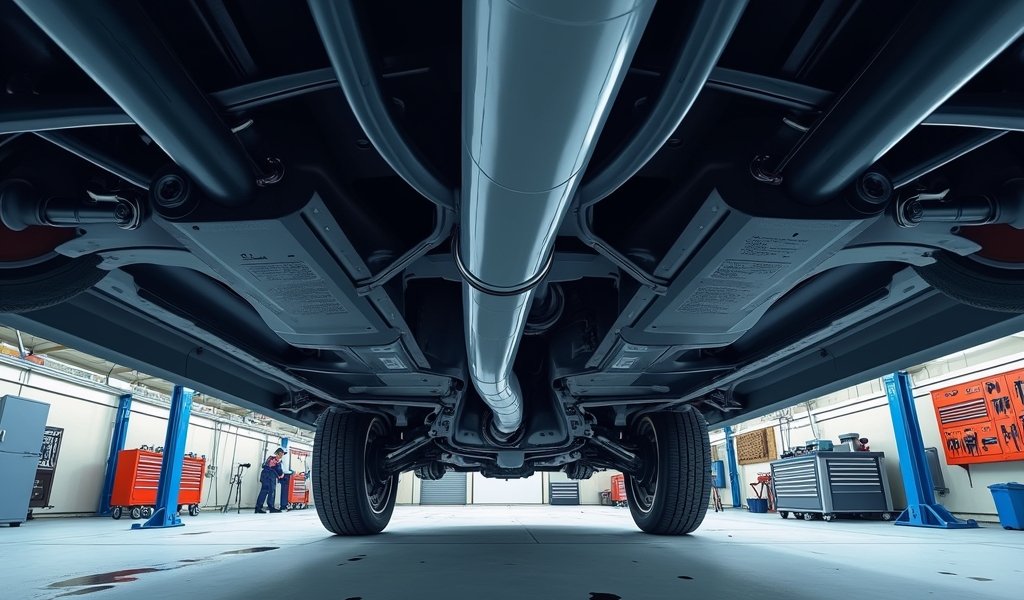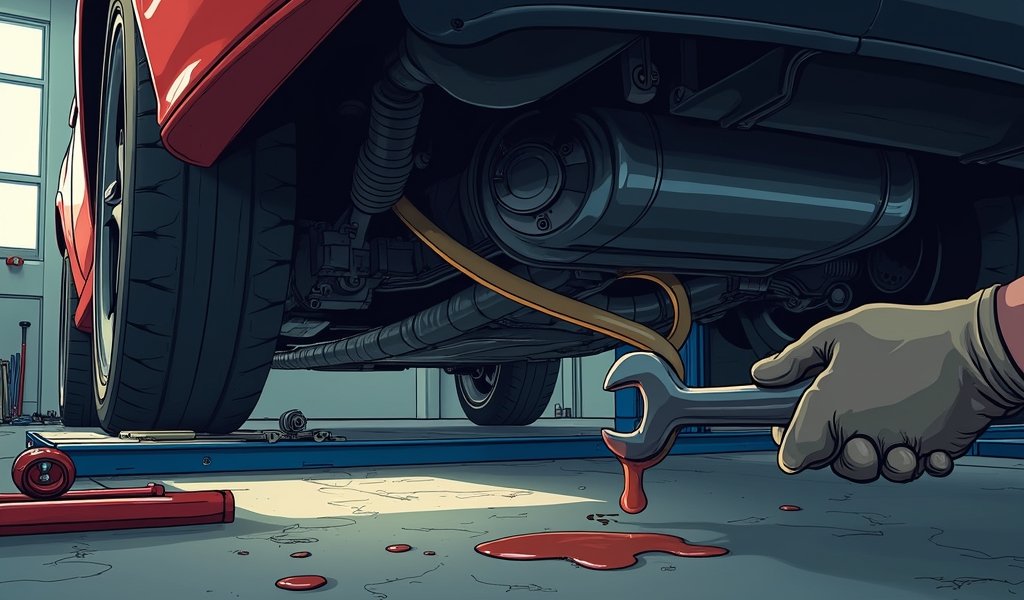Overview
This guide details proper transmission cooler line routing to prevent damage and extend transmission life, covering planning, installation techniques, and maintenance across various vehicle types. It emphasizes avoiding heat sources, securing lines properly, using appropriate materials, thorough testing, and regular inspection to prevent costly transmission failures.
Table of Contents
- Understanding Transmission Cooling Systems: The Basics
- Planning Your Transmission Cooler Line Route: Preparation Is Key
- Step-by-Step Routing Procedures: The Right Way
- Vehicle-Specific Routing Challenges: Tailored Solutions
- Connecting to the Transmission and Cooler: Precision Matters
- Testing Your Installation: Trust But Verify
- Troubleshooting Common Issues: When Things Go Wrong
- Maintenance Tips for Transmission Cooler Lines: Long-Term Care
- Conclusion: The Road Ahead
- Frequently Asked Questions
If you’ve ever looked under the hood of your vehicle, you’ve probably noticed a maze of hoses, lines, and tubes. Among these unsung heroes are your transmission cooler lines – vital components that quietly keep your transmission from overheating. At our shop, we’ve seen countless avoidable transmission failures simply because these lines weren’t properly routed. I’ve put together this comprehensive transmission cooler line routing guide to help you understand the importance of correct installation and how to do it right the first time.
Whether you’re a weekend warrior tackling DIY projects, a professional looking to brush up on best practices, or simply want to understand what’s happening when you take your vehicle to a qualified mobile mechanic, this guide has you covered. Let’s dive into the world of transmission cooling and learn how proper line routing can save you thousands in potential repair costs.
Understanding Transmission Cooling Systems: The Basics
Your transmission is essentially the heart of your drivetrain. Just like your own heart, it works hard and generates significant heat during operation. Without proper cooling, this heat can break down transmission fluid and damage internal components, leading to costly repairs or even complete failure.
Most vehicles come with factory transmission coolers integrated into the radiator. These stock setups work fine for normal driving but often prove inadequate for towing, hauling, or performance applications. This is where auxiliary transmission coolers come into play.
A complete transmission cooling system includes:
- The transmission itself (the heat source)
- Transmission cooler lines (transport system)
- Cooling unit (factory radiator section and/or auxiliary cooler)
- Fittings and connections
- Mounting hardware
When these components aren’t properly installed—particularly when lines are incorrectly routed—serious issues can develop. Kinked lines restrict flow, lines placed too close to exhaust components can cause fluid breakdown, and poorly secured mounting can lead to chafing and eventual leaks. According to a Society of Automotive Engineers study, nearly 40% of transmission failures are related to cooling system issues.
Planning Your Transmission Cooler Line Route: Preparation Is Key

Just like a good road trip needs a solid plan, your transmission cooler line installation deserves careful preparation. Before you grab a single wrench, take time to map out your approach.
Start by considering these critical factors:
- Available space within your engine bay
- Proximity to heat sources (exhaust manifolds, pipes, catalytic converters)
- Location of moving components that could damage lines
- Accessibility for future maintenance
- Protection against road debris
Try using a length of string or flexible wire to physically map your intended route. This simple trick can help you visualize the path before committing to it. Remember to measure the total distance required, adding 10-15% extra length for curves and connections.
Selecting the right line material makes a huge difference in durability and performance:
- Steel lines: Excellent heat resistance but limited flexibility
- Rubber lines: Good flexibility but less durability in high-heat environments
- Braided stainless lines: The best of both worlds with flexibility, strength, and heat resistance
Your toolkit should include:
- Line wrenches or flare-nut wrenches (regular wrenches can damage fittings)
- Tubing cutter (for steel lines)
- Flaring tool (if creating custom steel lines)
- Zip ties or line clamps
- Thread sealant compatible with transmission fluid
- Safety equipment (glasses, gloves)
- Fluid catch pan
Step-by-Step Routing Procedures: The Right Way
Let’s roll up our sleeves and get to the hands-on part. Here’s how to route your transmission cooler lines properly, step by step.
Preparing Your Vehicle
First things first – safety comes first! Ensure your vehicle is completely cool before starting. Transmission fluid can reach temperatures over 200°F during operation, which will give you a nasty burn. Disconnect the battery to prevent electrical issues, and place a catch pan under your work area for inevitable spills.
Removing Old Lines (If Applicable)
If you’re replacing existing lines, carefully disconnect them from both the transmission and cooler ends using the proper line wrenches. Take a few photos before removal to reference the original setup. Pay special attention to fitting orientations and routing paths – your phone’s camera is your best friend here!
Routing Best Practices
The golden rule of transmission line routing is simple: avoid heat sources like they’re your ex at a family gathering. Maintain at least 3-4 inches of clearance from exhaust components whenever possible. Remember that heat is the number one enemy of transmission fluid and lines.
Secure your lines approximately every 12-18 inches using appropriate clamps or ties. Think of these as the support system that prevents vibration damage over thousands of miles. When routing, maintain gentle curves rather than sharp bends – a good rule of thumb is keeping bend radius at least five times the diameter of the line itself.
Be particularly vigilant about avoiding:
- Moving components like fan blades, belts, and suspension parts
- Sharp edges that could cut into lines over time
- Areas exposed to road debris
- Tight spaces that make future service difficult
The experts at Motor Trend recommend routing lines along existing harnesses or frame rails when possible. This provides natural protection and often follows the vehicle manufacturer’s intended paths for fluid lines.
Vehicle-Specific Routing Challenges: Tailored Solutions
Not all vehicles are created equal, and neither are their transmission cooling needs. Let’s look at some specific scenarios you might encounter.
Trucks and Towing Vehicles
If you’re setting up a truck for towing, you’ll need to account for the increased heat load. Consider using larger diameter lines (-8AN or -10AN) to increase flow capacity. Route auxiliary cooler lines through areas with maximum airflow, and add additional securing points to counter the increased vibration these workhorses experience.
For serious towing applications, I recommend a dedicated auxiliary cooler with its own mounting location separate from the radiator. This provides the most efficient cooling when you’re pulling that boat up the mountain on a hot summer day.
Sports Cars and Performance Vehicles
Performance vehicles present unique challenges with their compact engine bays and higher operating temperatures. Finding the optimal path requires some creativity, like a game of automotive Tetris. Prioritize heat protection above all else, and consider heat-reflective sleeves for sections that must pass near exhaust components.
Many performance enthusiasts opt for specialized transmission service to ensure their cooling systems can handle track days or spirited driving. The investment is far less than replacing a cooked transmission.
Limited Space Configurations
For vehicles with cramped engine compartments, pre-planning becomes even more critical. Sometimes routing lines along the frame rail or through existing cable channels can provide the clearance needed. Don’t be afraid to temporarily remove components like air intake ducting to gain better access during installation.
Off-Road Vehicle Considerations
Vehicles destined for the trail need additional protection against undercarriage damage. Route lines above frame rails where possible, and use protective sleeves or conduit in exposed areas. Always consider the full range of suspension movement when planning your route to ensure lines remain undamaged during articulation.
Connecting to the Transmission and Cooler: Precision Matters

The connection points represent the most common locations for leaks in transmission cooling systems. Approach these areas with the precision of a surgeon.
Begin by thoroughly cleaning all fitting surfaces. Any debris can compromise the seal and lead to leaks. Apply appropriate thread sealant to pipe thread fittings, but never use Teflon tape – it can break off and contaminate your transmission. For flare or O-ring fittings, ensure proper alignment before tightening.
When tightening connections:
- Start by hand to prevent cross-threading
- Tighten to the manufacturer’s specifications using the appropriate wrench
- For AN fittings, apply a small amount of assembly lube to the threads only
- Avoid over-tightening, which can damage fittings or split lines
If you need to adapt between different fitting types, invest in quality adapters specifically designed for transmission systems. The few extra dollars spent on proper fittings will save you hundreds in potential cleanup and repair costs.
Testing Your Installation: Trust But Verify
Even the most carefully installed system requires thorough testing before hitting the road. Consider this the shakedown cruise of your new setup.
Start with a static pressure test if possible. Many professional shops can pressure test your system before adding fluid. If that’s not available, fill the system and check for visible leaks with the engine off.
Once initial testing shows no leaks, start the engine and allow it to reach operating temperature. Check all connections again for seepage or drips. Then, take your vehicle for a test drive, gradually increasing duration and intensity while monitoring transmission temperatures if you have a gauge.
During the break-in period, check your connections after each of the first few drives. Sometimes thermal cycling can reveal leaks not evident during initial testing. This vigilance can catch small issues before they become big problems.
Troubleshooting Common Issues: When Things Go Wrong
Even with careful planning, issues can arise. Here’s how to address common problems you might encounter.
Leaks
If you discover leaks, first determine the exact source. Fluid traveling along a line can make the origin point difficult to identify. Clean the area thoroughly and apply talcum powder near suspected leak points – transmission fluid will create visible paths through the powder.
For fitting leaks, ensure they’re tightened to specification and check for damaged threads or sealing surfaces. Line leaks typically require replacement of the damaged section.
Flow Restrictions
If your transmission runs hotter than expected after installation, you may have flow restrictions. Common causes include kinked lines, undersized lines for your application, partially blocked coolers, or improperly installed fittings restricting the internal passage.
Verify flow by disconnecting the return line (with the engine off) and placing it in a container. When an assistant briefly starts the engine, you should see a steady stream of fluid. Intermittent or weak flow indicates a restriction that needs addressing.
Routing Mistakes
Sometimes evidence of routing mistakes comes later – melted lines near exhaust components, chafed sections against moving parts, or lines that pull tight during suspension movement. Address these issues immediately, as they will only worsen with time.
If you encounter problems beyond your comfort level, don’t hesitate to call in a professional radiator repair service. The cost of expert assistance is invariably less than replacing a transmission.
Maintenance Tips for Transmission Cooler Lines: Long-Term Care
Like any vehicle system, transmission cooling components benefit from regular inspection and maintenance. I recommend establishing a quarterly visual inspection of all accessible lines and connections.
Watch for these warning signs:
- Fluid seepage at connections
- Discoloration of lines (indicating heat damage)
- Chafing or wear marks
- Brittle or cracked rubber sections
- Rust on steel lines
Preventative maintenance should include:
- Checking and tightening line clamps
- Replacing degraded insulation or protective sleeves
- Cleaning accumulated road grime that can trap heat
- Flushing the cooling system when changing transmission fluid
For vehicles subject to extreme conditions, consider upgrading to more durable components before failure occurs. The modest investment in premium lines and fittings can prevent costly transmission repairs down the road.
Conclusion: The Road Ahead
Proper transmission cooler line routing might seem like a small detail in the grand scheme of vehicle maintenance, but it plays a pivotal role in your transmission’s health and longevity. By following the principles outlined in this guide, you’re not just avoiding potential problems – you’re actively extending the life of one of your vehicle’s most expensive components.
Remember the key takeaways:
- Plan your route carefully, avoiding heat sources and moving components
- Select appropriate materials for your specific application
- Secure lines properly to prevent movement and chafing
- Test thoroughly before returning to regular driving
- Inspect regularly as part of your maintenance routine
Whether you’re enhancing your towing capacity, preparing for track days, or simply ensuring your daily driver provides reliable service for years to come, a properly designed and installed transmission cooling system is an investment that pays dividends with every mile.
Got questions about your specific setup? Drop me a line in the comments, or consider consulting with a professional for tailored advice. Your transmission will thank you!
Frequently Asked Questions
How often should transmission cooler lines be replaced?
Transmission cooler lines should be inspected annually and replaced if showing signs of damage, leaks, or deterioration. Most quality lines will last 7-10 years under normal conditions.
Can I route transmission lines near the exhaust?
Never route transmission lines near exhaust components if possible. If unavoidable, maintain at least 3-4 inches of clearance and use heat shields or high-temperature protective sleeves.
What’s the best material for transmission cooler lines?
Braided stainless steel lines with quality fittings offer the best combination of heat resistance, durability, and flexibility for most applications. They cost more initially but provide superior long-term reliability.
How do I know if my transmission is overheating?
Warning signs include a burning smell, transmission fluid that looks dark or smells burnt, and sluggish shifting performance. Installing a transmission temperature gauge is the most reliable way to monitor temperatures.
Do I need an auxiliary transmission cooler if I’m not towing?
Not necessarily, but an auxiliary cooler benefits any vehicle driven in hot climates, heavy traffic, or mountainous terrain. It’s cheap insurance against expensive transmission repairs.

